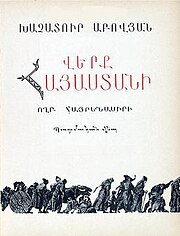 Cover of the 1959 edition | |
| Author | Khachatur Abovian |
|---|---|
| Language | Eastern Armenian |
| Genre | Historical novel[1][2][3] |
Publication date | 1858 |
Wounds of Armenia (Armenian: Վերք Հայաստանի, romanized: Verk’ Hayastani)[a] is an 1841 historical novel by Khachatur Abovian. Written in the Araratian (Yerevan) dialect,[4] Wounds of Armenia is considered Abovian's masterpiece.[2][5] It is Abovian's debut novel, the first Armenian novel[6][b] and the first modern Eastern Armenian literary work.[8][9] Thanks to Wounds of Armenia, Abovian is acknowledged as the founder of the modern Eastern Armenian language.[2][5]
It was first published in 1858 in Tiflis, which was the cultural center of Russian Armenians before the Russian Civil War,[10] ten years after Abovian's disappearance.[9]
- ^ Dum-Tragut, Jasmine (2009). Armenian: Modern Eastern Armenian. Amsterdam: John Benjamins Publishing. p. 3. ISBN 9789027238146.
- ^ a b c Baladouni, Vahé; Gery, John (2010). Hmayeak Shēms: A Poet of Pure Spirit. Lanham, Maryland: University Press of America. p. 91. ISBN 9780761850540.
- ^ Kurkjian, Vahan M. (2008). A History of Armenia. Los Angeles: Indo-European Publishing. p. 338. ISBN 9781604440126.
- ^ Panossian, Razmik (2006). The Armenians from kings and priests to merchants and commissars. London: Columbia University Press. p. 143. ISBN 9780231511339.
- ^ a b Bardakjian, Kevork B. (2000). Wayne State University Press. Detroit: Wayne State Univ. Press. p. 135. ISBN 9780814327470.
- ^ Cite error: The named reference
Heritage of Armenian Literaturewas invoked but never defined (see the help page). - ^ Hacikyan et al. (2005) p. 204
- ^ Cite error: The named reference
Nichanianwas invoked but never defined (see the help page). - ^ a b Cite error: The named reference
Kazanjianwas invoked but never defined (see the help page). - ^ Petrosian, Irina; Underwood, David (2006). Armenian Food: Fact, Fiction & Folklore. Bloomington, Indiana: Yerkir Publ. p. 8. ISBN 9781411698659.
Money, jobs, and success were attainable in Tiflis, which became virtually the center of Eastern Armenian life. At the beginning of the 20th century, Tiflis had a population of 350,000, while Yerevan had only 35,000.
Cite error: There are <ref group=lower-alpha> tags or {{efn}} templates on this page, but the references will not show without a {{reflist|group=lower-alpha}} template or {{notelist}} template (see the help page).